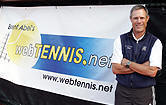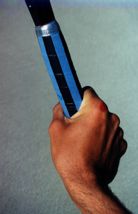|
 Custom Search Introduction The backhand is generally more difficult to learn than the forehand. There are three distinct strokes: the one-hand topspin stroke, the two-handed topspin stroke, and the slice which is best achieved as a one-handed stroke).The most popular shot now among advanced players is the topspin stroke. Many of today's top players have two-handed stroke. The advantages are obvious and so are the limitations. For most players, this stroke is an intimidating shot. The fear is not necessary. The motion is not foreign; in some ways we do the same thing when we throw a Frisbee or deal cards. The keys to overcoming this anxiety are the mastery of footwork, shoulder turn, racket preparation, and follow through. After that, the rest is merely practice. A few basics that apply to all tennis shots: watch the ball at all times; always take the ball with your momentum going forward, if possible; always take the ball on the rise. Practice looking the ball into the racket face by simply bouncing a ball off the face of it until you can do it 100s of times without missing.
The most popular shot now among advanced players is the topspin backhand. Basic information about this stroke: the racket starts below the ball; the player brings the racket up and through the ball, closing the face of the racket on the follow through. The shot will take an overspin that will bring the ball down. The sweep of the racket from below to above will determine the trajectory.
The Extreme Backhand Grip 1. Starting Position Wait for the ball by standing on the center strip holding the racquet with both hands in front of your body as loose as possible. At this point, you are waiting for a shot so you can switch your grip easily for a forehand or a backhand grip. By letting the arms hang and the knees relax then let the torso bend forward the same degree as the upper legs to get balanced. When the body is balanced the arms can swing freely. The majority of your weight must be on your toes toes- do not stand flat-footed. Your knees must be slightly bent. 2. Get the racket back Once you see that the ball is going to your backhand, get the racquet back in anticipation of the shot with your backhand grip ready. For the average player, getting the racquet back is a must to enable him to hit the shot in position. As soon as you get your backhand grip on the racquet you should bring the racquet and shoulders back so that you will be ready to strike the ball when it arrives. The fingertips of the non-dominant hand should remain on the throat of the racquet until you swing forward at the ball. The shoulders should be turned a little more so that your upper body is facing slightly away from the ball. Your toes should be pointing perpendicular to the direction that the ball is traveling. The foot closest to the ball (right foot for righties) should be positioned slightly in front of the body with the other foot trailing behind the body. The knees should be bent moderately. The elbow on the dominant arm is kept near the body and bent comfortably. Keep your elbow close to your body until follow-through. The racquet should be held slightly below the point of contact and follow a strictly low-to-high swing pattern. The face of the racquet should be perpendicular to the ground. If the racquet face is tilted up or down then you will likely hit the ball too high/long or into the net. Eyes should remain focused on the ball. 3. Position when hitting the ball After you have your racquet back in the ready position it is now time to move yourself into the appropriate position to hit the ball. You can get yourself into better position if you have your racquet back before you move to the ball. Without having your racquet back, you don't have a good notion of where you need to be. When moving into position, you should strive to be as smooth as possible. You want to glide into position while always maintaining your balance. Staying up on your toes will help you achieve this. Ideally, you would like to position yourself so that when you bring your racquet straight around your body, you will contact the ball on the sweet spot of the racquet and about a foot in front of the body. For lower balls you should bend your knees to get your upper body down to the level of the ball. You do not want to "scoop up" low balls by bending over and using a non-horizontal swing. 4. The swing The backhand swing should be powered by the body -- not the arm or wrist. The wrist must remain locked in position. The idea is to turn your upper body, making it pull the racquet around and through the ball (sometimes refered to as uncoiling). Your upper body should slingshot your arm forward. When you contact the ball, the tennis racquet should be about a foot in front of the front edge of your body. At this point, the racquet must be square to the direction you wish to hit the ball. If your racquet is tilted up, down, left or right then the ball is going to go in that direction. Once again, keep your eyes on the ball. Just prior to contact is when many players will look up to see where they want to hit the ball, especially when their opponent is at the net. Don't do this! This is probably the most common cause of mishits. You must watch the ball all the way into the strings of your racquet. In fact, many teaching pros will tell you to leave your eyes focused on the point of contact for a full second after you have hit the ball. 5. The followthrough Just like baseball, golf, and many other sports, you will want to followthrough after you have struck the ball. You don't want to jolt the racquet to a sudden stop right after you contact the ball. Let the racquet go "through" the ball while traveling from low to high. To maintain balance, let the non-dominant arm swing behind the body while the dominant arm (and racquet) swing to the front.
 Brent Abel is highly recommended to: • Dramatically improve your tennis strokes... - tennis serve - one-handed backhand groundstroke - forehand groundstroke - two-handed backhand groundstroke - forehand and backhand volleys - returns of serve for singles & doubles - overhead - lob - drop shot • Understand the simple yet essential keys to footwork. • Develop the necessary mental skills for practice and competition • Be more focused on court positioning - Finally understand exactly how superior court positioning in your singles and doubles strategies can have an enormous effect on challenging your opponents. • Get fitter and learn simple exercises for tennis specific injury prevention, greatly reduce the risk of tennis elbow, rotator cuff, and other tennis related injuries • Learn to become an "all-court" tennis player instead of just being a one-dimensional predominantly baseline player • Enjoy this beautiful game throughout your lifetime. Go to his site, WebTennis.net.

 Custom Search HOME
|
